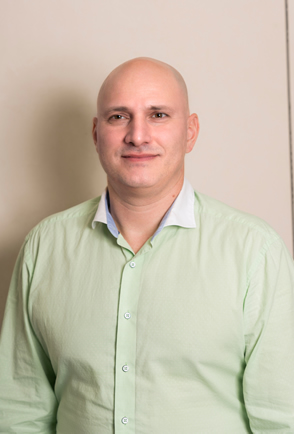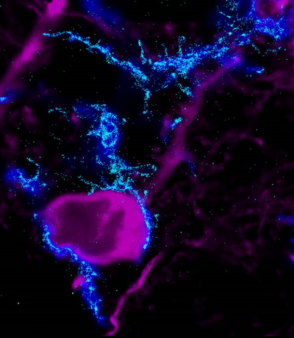
Ádám Dénes, biologist, head of the Momentum Laboratory of Neuroimmunology at the Institute of Experimental Medicine of the Hungarian Academy of Sciences (MTA KOKI), winner of the ERC Consolidator Grant last year
How did this extensive research of Ádám Dénes start and what questions has it already answered? Ádám Dénes - head of the Momentum Laboratory of Neuroimmunology at the Institute of Experimental Medicine of the Hungarian Academy of Sciences (MTA KOKI), winner of the ERC Consolidator Grant last year - spent a long time at the University of Manchester, where he coordinated the research done by the research group studying the role of inflammation in stroke as part of the European Stroke Network, a programme of the European Union. They found that inflammatory processes in the brain are important contributors to brain injury and diseases of the nervous system, in general. Surprisingly, these processes often start outside the brain. Several common non-communicable diseases (e.g. diabetes, arteriosclerosis, obesity, hypertension) represent a state of chronic, systemic inflammation, which might also affect cerebral inflammatory processes. This is, in part why these diseases predispose patients to neurological diseases, e.g. stroke, epilepsy, Alzheimer and Parkinson’s disease, what is more, for depression and certain mental disorders.
Cerebral inflammatory processes are predominantly regulated by the so-called microglial cells. Researchers concluded during their studies that the functioning of microglial cells has already changed in patients suffering from chronic inflammation and living with several stroke risk factors but without an obvious sign of any neural disease: microglia in these patients showed increased activity. Interestingly, increased incidence of stroke-events may as well be evidenced late autumn and early spring, the “peak” season of respiratory infections. In experimental studies it has also been shown that inflammation does not only predispose to, but actively contributes to the evolution of brain injury after stroke or in other brain diseases. At the same time, blocking inflammatory processes reduces risks, therefore the understanding of these processes may yield novel therapeutic opportunities in medicine of the future.
What happens if the microglial cell is “switched off”, like a lamp? This is the question Ádám Dénes set about to study at MTA KOKI after he returned home. Fortunately, he has managed to secure funding to proceed with his research. Over the past years new sources of funding have been deployed to provide the financial background of national research and encourage researchers to stay in their home country, demonstrating a strong intention of the government. This intention is also reflected by the competitive calls invited in the Momentum Programme, the National Brain Research Programme or the NRDI Fund. The work of Ádám Dénes was also supported by an unexpected discovery of a substance in one of the pharmaceutical companies cooperating with his research group, which blocks one of the key pathways required for the self-maintenance of the microglial cells in the brain, without having any serious effect on any other cells in the organism. This substance has made it possible to selectively eliminate microglial cells from the brain for first time without causing inflammation or damage. A few weeks after the administration of the substance was stopped, the proliferating microglial cells returned to the brains of the test animals, to the places where they had been located originally.
When mice with microglial deficiency were exposed to an experimental stroke, neuronal death increased by 60% compared to the control group. However, the return of microglial cells to the brain reversed this effect!
The next important stage of research was the establishment of contacts between Ádám Dénes and the KOKI research group of Balázs Rózsa. The two groups working together was the first to combine selective manipulation of microglial cells with advanced imaging technology, which enabled the examination of cerebral inflammatory processes and the activity of damaged neurons after brain damage in real time. High resolution, in vivo two-photon microscopy demonstrated how the functioning of the microglial cells is related to the activity of neurons. They found that the more active the neuron becomes, the more it will be encompassed by the processes of the microglia. After the elimination of microglial cells, the functioning of the neuronal network became dysregulated, leading to increased neuronal death in the injured brain. In further studies, the research group of Ádám Dénes also found that neurons are contacted by microglia in an activity-dependent manner also in the healthy brain. Therefore, the relationship between the microglia and neurons is not limited only to pathological cases.
How does the microglia connect with neurons, and how does it interfere with their functioning? With a view to examine this, the research group of Dénes Ádám made use of the high-resolution microscopy imaging, which had not been used earlier to study the relationship between microglia and neurons. By using superresolution microscopy enabling a lateral resolution of 20 nanometers they managed to visualize receptors which maintain the “dialogue” between microglia and the neurons.

Microglia-neuron relationship in the brain
The image made by the superresolution microscopy shows the distribution of receptors on microglia contacting a neuron that are essential in these interactions
(by Barbara Orsolits)
Microglia-neurons interactions have also been examined in 3D by applying a new and costly method, electron tomography -, and importantly, not only in the brains of mice, but in post mortem human samples, as well. It was shown that the receptors mediating microglia-neuron communication accumulate at the specific interaction sites of the two cells. “Anchor” points are also found in neurons represented by the enrichment of molecules playing a role in the transmission of intercellular signals - some of which have already been identified. This indicates the discovery of a new, so far unexplored microglia-neuron communication hot spot in the brain. Since this morpho-functional unit is present in most neurons, it is expected that it might be important in several diseases of the nervous system.
Microglia are not only responsible for the “dialogue” with healthy neurons: they also eliminate dysfunctional synapses and infected or terminally injured neurons from the brain. This “cleaning” must be extremely accurate and regulated, as an error made by the microglia would lead to a devastating outcome. The measurements and calculations made by the research group of Ádám Dénes show that our microglia cells could “eat up” our brains in as few as 100 hours! How do microglia decide what to eliminate making it possible that we can live up to 100 years of age? It has also become clear that microglia recognise damaged cells partly with the help of receptors used to communicate with neurons. Researchers have also identified molecules on the surface of injured neurons, which contribute to the phagocytosis of damaged cells. Collectively, these studies and other relevant data from the literature indicate that several, previously unrecognised immune processes take place in the nervous system. Dysregulation of brain immune processes and errors in the recognition or clearance of injured cells are likely to shape the outcome of common human brain diseases. In addition to the rapidly accumulating research data, a number of questions are still open. Understanding inflammatory mechanisms in the brain could lead to the development of new drugs with high therapeutic potential.
Work has been undertaken within the framework of the National Brain Research Programme. The research group of Ádám Dénes includes 1 senior researcher, 3 post-doctors, 4 PhD students, 1 technician and 3-4 university students participating in Students’ Scholarly Circle.






